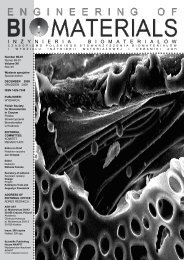88 - Polskie Stowarzyszenie BiomateriaÅów
88 - Polskie Stowarzyszenie BiomateriaÅów
88 - Polskie Stowarzyszenie BiomateriaÅów
Create successful ePaper yourself
Turn your PDF publications into a flip-book with our unique Google optimized e-Paper software.
20<br />
Resorbowalne płytki<br />
polimerowe w chirurgii<br />
twarzowo-szczękowej<br />
Barbara Szaraniec, Michał Dworak, Jan Chłopek<br />
Akademia Górniczo-Hutnicza,<br />
Wydział Inżynierii Materiałowej i Ceramiki,<br />
Katedra Biomateriałów,<br />
Al. Mickiewicza 30, 30-059 Kraków<br />
Streszczenie<br />
Wstęp<br />
Praca przedstawia wstępne wyniki dotyczące<br />
otrzymywania i badań właściwości mechanicznych<br />
resorbowalnych płytek dla chirurgii twarzowoszczękowej<br />
wykonanych z polilaktydu oraz kompozytu<br />
polilaktyd/TCP. Płytki otrzymano metodą wtrysku z<br />
biodegradowalnego, termoplastycznego poli-L-laktydu<br />
(PLLA, Biomer) oraz proszku fosforanu triwapnia<br />
(TCP, Fluka). Na maszynie wytrzymałościowej<br />
Zwick 1435 przeprowadzono badania mechaniczne.<br />
W próbie rozciągania określono wytrzymałość, moduł<br />
sprężystości, odkształcenie przy sile maksymalnej oraz<br />
na podstawie testów pełzania wyznaczono zależność<br />
pomiędzy naprężeniem a czasem zniszczenia.<br />
Słowa kluczowe: polilaktyd, pełzanie, kompozyty<br />
polimerowe<br />
[Inżynieria Biomateriałów, <strong>88</strong>, (2009), 20-23]<br />
Zainteresowanie współczesnej chirurgii implantami z<br />
polimerów resorbowalnych i ich kompozytów stale wzrasta.<br />
Możliwość sterowania parametrami mechanicznymi i<br />
czasem resorpcji pozwala na uzyskanie szerokiej gamy<br />
degradowalnych w środowisku biologicznym materiałów<br />
implantacyjnych. Niewątpliwym atutem tego typu materiałów<br />
jest fakt, iż nie wymagają usunięcia z organizmu,<br />
a tym samym przeprowadzenia powtórnej operacji chirurgicznej<br />
[1,2]. Jedną z istotnych przyczyn ograniczających<br />
możliwości zastosowania polimerów resorbowalnych na<br />
implanty pełniące funkcję biomechaniczną (na przykład<br />
jako elementy zespalające) jest ich niska wytrzymałość<br />
oraz występujące powszechnie zjawisko pełzania [3].<br />
Nawet jeśli wszczep poddawany jest niewielkim obciążeniom<br />
mogą one w stosunkowo niedługim czasie spowodować<br />
obluzowanie zespolenia lub doprowadzić do<br />
zniszczenia implantu. Dlatego w przypadku polimerów oraz<br />
kompozytów polimerowych istotne jest określenie dopuszczalnych<br />
obciążeń pozwalających na bezpieczną realizację<br />
przez nie funkcji biomechanicznych [4].<br />
Materiały i metody<br />
Badaniom poddano trójramienne mini-płytki (Y) z polilaktydu<br />
(PLLA) oraz polilaktydu modyfikowanego cząstkami<br />
fosforanu triwapnia (PLLA/TCP) (rys. 1). Płytki otrzymywano<br />
metodą wtrysku na wtryskarce ślimakowej Multiplas przy<br />
temperaturze z zakresu 170-180 o C oraz ciśnieniu 45 MPa.<br />
Do otrzymania próbek użyto polilaktydu BIOMER ® 9000<br />
(Biomer, Niemcy) oraz fosforanu triwapnia (Fluka, Niemcy).<br />
Resorbable polymer plates<br />
in maxillofacial surgery<br />
Barbara Szaraniec, Michał Dworak, Jan Chłopek<br />
AGH University of Science and Technology,<br />
Faculty of Materials Science and Ceramics,<br />
Department of Biomaterials,<br />
30 Mickiewicz Ave., 30-059 Krakow, Poland<br />
Abstract<br />
The presented work demonstrates preliminary<br />
results on manufacturing and mechanical properties<br />
assessment of pure PLLA and PLLA/TCP composite<br />
plates, as potential candidates for maxillofacial<br />
surgery application. Biodegradable, thermoplastic<br />
polymer poly-L-lactide (PLLA, Biomer) and tricalcium<br />
phosphate (TCP, Fluka) particles were applied for the<br />
samples manufacturing in injection moulding process.<br />
The plates were investigated using universal testing<br />
machine Zwick 1435 – in static tensile and creep tests.<br />
The mechanical properties (tensile strength, Young<br />
modulus, elongation) of the polymer and its composite<br />
were determined and the lifetime, performed with the<br />
scope of their potential application in osteosynthesis,<br />
were predicted.<br />
Keywords: polylactide, creep, polymer composites<br />
[Engineering of Biomaterials, <strong>88</strong>, (2009), 20-23]<br />
Introduction<br />
Resorbable polymers and their composites are the materials<br />
of raising interest and hopes due to their high potential<br />
for the use in surgical applications. Their design allows to<br />
develop materials with time-controllable properties fully biocompatible<br />
with body tissues [1,2]. Application of such materials<br />
would not require additional surgery for the removal<br />
of the implant, because they will biodegrade into the substances<br />
removable from the body on the basis of natural cell<br />
metabolism processes. The use of bioresorbable polymer<br />
matrices is limited to implants working under low loads because<br />
of inherent low strength and prevalence of creep process<br />
among such a polymers [3]. That is why determination of<br />
permissible loads for such a polymers and their composites<br />
is essential in order to ensure secure realization of their biomechanical<br />
functions. Additionally, the biomechanical function<br />
of these materials will be fulfilled for a limited time only,<br />
which will be adjusted to tissue regeneration process [4].<br />
Materials and methods<br />
Two types of Y-shaped mini plates made of pure polylactide<br />
(PLLA) and polylactide modified with 7%wt. tricalcium<br />
phosphate particles (PLLA/TCP) were investigated (fig. 1).<br />
Plates were manufactured by injection moulding – vertical<br />
injection machine Multiplas V-4S at temperature 170-180°C<br />
and injection pressure of 45 MPa. Polylactide BIOMER ® 9000<br />
(Biomer, Germany) and tricalcium phosphate (Fluka, Germany)<br />
were used.<br />
Mechanical properties of the plates were investigated in<br />
uniaxial tension test. For pure PLLA and PLLA/TCP composite<br />
tensile strength, Young’s modulus and elongation at<br />
maximum force were determined. Plates were attached to<br />
wooden blocks with metal screws as shown in fig. 1b.













